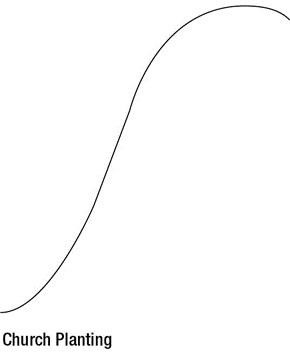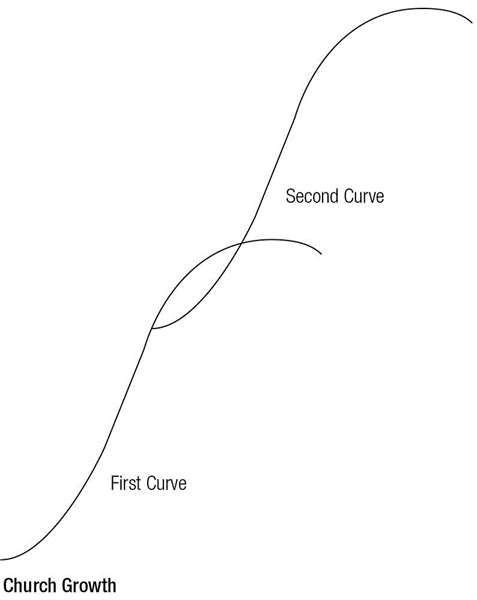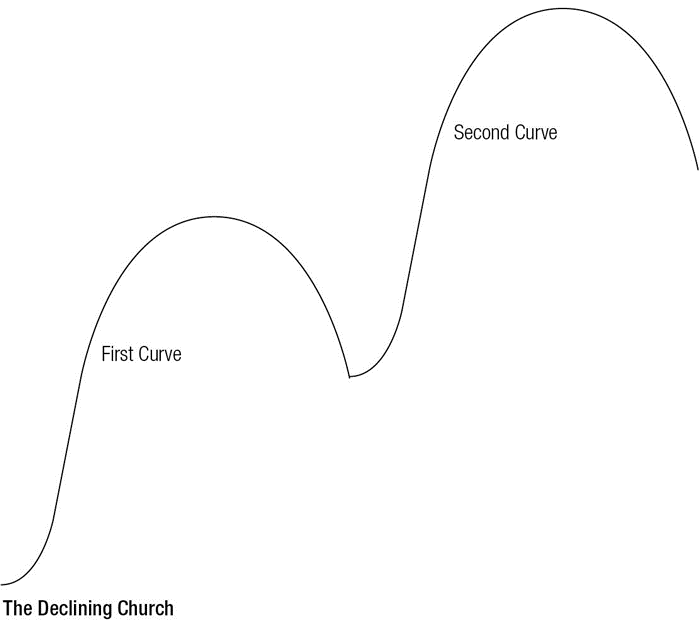The Solution
The concept of the sigmoid curve raises a critical question for the North American church. Is there anything a church can do to circumvent or at least put off eventual decline and death? The answer is yes, and it is twofold. First, gifted leaders of churches and denominations must start new S-curves. They need to launch out in new directions. Second, they need a strategic planning process that helps them start new sigmoid curves. They need to know how to think and act in the twenty-first century.
Starting New S-Curves
The answer to the problem of church decline is to start new S-curves. This should occur in several contexts: church planting, church growth, and church revitalization. You would be wise to pay close attention to the context that describes your ministry situation.
CHURCH PLANTING
The first context in which to start new S-curves is new church starts. Birthing new churches was the early church’s response to Christ’s Great Commission. The church’s three missionary journeys found in Acts 13:1–21:26 involved church planting.
A number of organizations and denominations have caught a vision to parent Great Commission churches all across North America. They refuse to bury their heads in the sand and ignore all that is taking place around them. The Assemblies of God and the Southern Baptists launched bold church-planting programs at the end of the twentieth century. A number of smaller denominations such as the Missionary Church, Lutheran Church–Missouri Synod, Evangelical Covenant Church, Church of the Nazarene, and others have followed suit.
Church planting involves starting a new or first S-curve. The new church has no prior history. It is at the very beginning of the church life cycle. While this can be a very disorganized time in the church’s history, it is also a time of great excitement and anticipation. The core group is asking, What is God going to do? To what extent will God use us to make a difference in our world in the twenty-first century? Typically, churches at this early stage are very evangelistic and reach out to people in the community and beyond.
The concept of the S-curve teaches us that for the universal church to survive, it must plant churches. Since every church in time will wane and die, it is imperative that we start new churches, or the church as a whole will cease to exist.
CHURCH GROWTH
The second context for new S-curves is the growing church. The key to continued growth and renewal is not only to start new first-curve churches (church planting) but also to start a new second curve in the existing church before it plateaus.
A proactive response. Like church planting, this is a proactive response. The church starts the second curve while it is still virile and growing. It is at this stage that the ministry has the time, resources (people and finances), energy, spirit, and drive to launch the new curve. Many in the church, however, will view this response as foolish if not insane (they have not learned from companies like IBM that made the exact same mistake and as a result don’t have the market share they once had). The problem and number one enemy is complacency. Why start a new course when the present course is so successful? Someone will quip, “If it ain’t broke, don’t fix it!” This calls for a strong leap of faith, as the need for and evidence in support of a new direction will not be obvious. This is a paradox. Leaders must push ahead in spite of the seeming evidence that the current ministry is doing well. This move is tantamount to letting go of the trapeze with no net in sight. It takes leaders of strong faith and vision to pull it off.

A reactive response. Most leaders wait until the church has plateaued or is in decline before they seek renewal. This is the crisis or reactive mode. But people do not lead and respond well in a crisis context for several reasons. One is that the leaders are discredited. They are the very ones who led the organization into its state of decline, so they are not considered competent as leaders or worthy of trust.
People will also respond poorly because of lack of resources. Declining ministries are like sinking ships. Some people are quick to abandon them and take their money with them. There will also be poor esprit de corps. People are down emotionally, which drains them of the energy needed to be involved in renewal.
Knowing where we are. At this point two important questions for growing churches are, How can we know where our church is on the first curve, and When it is time to start the second curve? The answer to both questions is that you cannot know for sure. However, the following hints may prove helpful. First, it is always safe to assume that you are close to a plateau. If you are not close, you can be sure that one is lurking somewhere off in the distance. Handy points out candidly that an organization needs a new direction every two to three years. This is because not only is there more change today, but also it happens in a shorter amount of time.
It may be helpful to ask an outsider (another pastor or consultant) for his evaluation of where the church is, because he will be more objective than people within the ministry. Younger people in the church and younger leaders will often be more aware of where the church is than older members. The older and established leaders may hold assumptions, views, or paradigms that blind them to the real situation. This is why I along with others advise older leaders and retiring pastors not to stay in the church. It is imperative that those who cannot embrace the new curve step aside and, usually, leave the church. This may seem harsh, but the church as a whole is more important than a handful of former leaders. These older leaders could move to other churches where they would be able to serve with less influence as lay leaders or as ministers in small group communities.
Some second-curve issues. Not only is it difficult to convince people in a growing church of the need to start a second curve, but it is also difficult to accomplish the new direction. For a time, various currents will be pulling in different directions. The old and new curves will coexist, causing much confusion. Conflict will surface between leaders and their followers invested in the first curve and those invested in the second curve. In addition, as the second curve starts up, it may wane before it takes over. The result will be even more criticism of the leaders of change, making it easy for them to lose heart, give up on the new curve, and return to the old or resign. The answer for leaders of change is to exercise great patience with the process. Do not be too quick to decide it’s not working.
Some second-curve events. How do growing churches launch new S-curves? What are some second-curve events? One is a church relocation. Lakepointe Baptist Church was a growing Southern Baptist church located in Rowlett, Texas (a suburb of Dallas), with an average of two to three thousand attenders. They relocated to a larger facility that is located four or five miles away, facing a four-lane interstate highway, and attendance has jumped to around seven thousand.
Another way to initiate a second curve is to implement some or all of the concepts in this book—discovering your core values; developing a mission, a vision, and a strategy; and so forth. For those who have already discovered and developed these concepts, begin a second curve by revisiting and updating or rethinking them.
Other second-curve events are the addition of a more contemporary worship service, transitioning the traditional church service to a contemporary service, adding a service to attract and win seekers, redesigning the traditional Christian education program, launching a vibrant small group ministry, and challenging all the people to go through a process of discovering their divine design and then investing their lives in some aspect of church ministry.
Warning. Every church is unique. Consequently, what works for one church may not work for another. Relocation worked well for Lakepointe—a healthy church. It could prove disastrous for you. The same is true for transitioning from a traditional to a more contemporary format, adding a service, and so on.
Some events result in deeper changes than others. A relocation or transition in style may bring changes only at the church’s edges. This depends on the church and its particular culture, needs, and problems. Usually the kinds of events that launch new S-curves result in substantial changes at the organization’s heart and not just around its edges. Often they involve a change in paradigm. While a church relocation or transition from one style to another is optional, discovering core values and developing a mission, vision, and strategy are not. When an entire church concurs and decides to pursue these, the result, most likely, will be a new S-curve.
CHURCH REVITALIZATION
The third context for starting a new sigmoid curve is the revitalization of plateaued or dying churches. The hope is that it is not too late for the church to be revived. A plateaued church can move in a new direction, starting the new S-curve while on the plateau. New problems may arise, however. When enough new people are coming into the ministry to offset those who are exiting, the leaders may find themselves dealing with some of the same challenges as those of growing churches.
If a church waits until it is dying to make changes, it finds itself in a reactive not a proactive mode. At this point it may be too late to start a new sigmoid curve. The church may have used up most of its resources in trying to keep the sinking ship afloat. Some people are willing to invest in a ship that is listing badly, but many head for the lifeboats. Those who decide to stay with the ship find themselves constantly wrestling with discouragement. As difficult as church planting and starting a new curve in a growing church are, revitalization of a declining ministry is more difficult and less likely to succeed. However, if a plateaued church is to survive, it must start a new S-curve as soon as possible and trust God to chart a new course.

Strategic Planning
The answer to the problem of church decline is to start new S-curves. This necessitates a strategic planning process along with leaders or navigators who can effectively lead their churches through the process. It is imperative that strategic planning be at the heart of starting new S-curves. The following provides an overview or a synthesis of the strategic planning process, which is developed in this book. It will help you see where each part fits and how all the parts work together to accomplish congregational development. You may find it helpful to consult the table of contents as you read the following. The strategic envisioning process or navigational compass is made up of three distinct parts, each of which has several elements that work to envision the church’s future.


The process begins in part 1—the ministry’s preparation for envisioning the future. Remember that preparation precedes process. It consists of three elements that prepare the ministry for what is to come. The first addresses the preparation of the lead navigator. It presents the rationale for strategic planning (chap. 1). It challenges leaders to address such vital issues as their definition of strategic planning and what they believe is its importance, the need for it, and its purpose. Most important, it asks if the navigator is the kind of leader who can lead the church through change. In addition, these issues are in a twelve-item checklist to aid navigators in deciding on and developing their rationale. The second element addresses the ministry’s preparation of the crew (chap. 2). It helps navigators prepare their team for the process. The third focuses on the boat or development of the strategy as the team works through the process (chap. 3).
Part 2 provides the process phase when the team begins to chart out their future. They will discover who they are, where they are going, and how they will get there. This part consists of four elements that guide leaders and their teams through the process of envisioning the ministry’s future: developing a mission, developing a vision, discovering core values, and developing a five-part strategy that accomplishes the mission-vision (chaps. 4–12).
Part 3 provides the practice phase when the navigational team continues the journey. It is made up of two elements (chaps. 13–14) that accomplish the results of the process phase. The first is launching the boat, which involves the implementation of the developed strategy. The second element is evaluation, which changes and fine-tunes the results of the process.
Strategic Leadership
The key to strategic planning is competent strategic leadership. You may develop the finest strategic plan in the history of the church. It may be featured in the major journals on leadership. You might publish it in a book that sells thousands of copies. However, it will not happen without competent, gifted leadership. In a way, this is a disclaimer. I have designed this book to help you develop a plan that “touches all the bases” and makes a significant difference in your church. However, it will not likely come to fruition without good leadership, especially at the senior pastor level.
Regardless of how new S-curves in a church are started—through church planting, growth, or revitalization—two interrelated pieces must always be present. One is a congregation that is ready to grow or be revitalized. The other is a competent pastor who is able to lead the ministry through change. So who are these pastors and what does this kind of leadership look like? What are the characteristics of pastor-leaders who can lead their churches to grow or be revitalized? Because of the critical nature of these questions and the importance of leadership to the entire process, I will address them at the beginning of chapter 1, “Preparing the Navigator.”